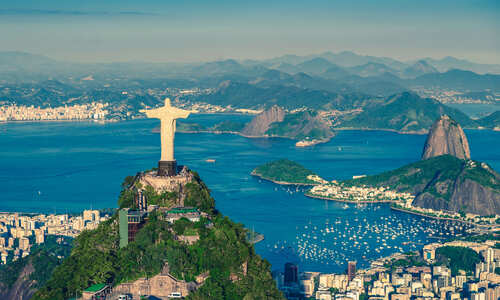Article content
15 July 2014 by Alex Stewart
Where to travel outside of peak season to avoid the crowds (and save money)
Do you want pretty perfect weather, no crowds and an attractive price? Try travelling in the window known as the shoulder season. This sweet spot between the high-priced peak season and poor weather of the low season is an ideal time to get away while maximising your travel budget. Browse the calendar to see where we recommend pre- or post-peak season.
Jump to: Jan | Feb | Mar | Apr | May | Jun | Jul | Aug | Sept | Oct | Nov | Dec
JANUARY
Although there are no significant off peak shoulder seasons around the world in January, look out for sales kick-starting the year, frequently with good value offers and last minute winter sun getaways on offer. Alternatively, consider the USA and head to New Orleans before the city's Mardi Gras madness or Florida, whose attractions are chillier but infinitely quieter at this time of year.
FEBRUARY
There are still no significant shoulder seasons around the world in February, so you'll need to look out for late running sales in order to secure a bargain. In the USA, Los Angeles is cooler but less crowded and the air is clean meaning that it's ideal for treks and impressive views. You could also take a risk and travel to somewhere like Venice, which will potentially be wet but consequently you'll have the city virtually to your self.
MARCH
In the USA in March travel to either New England, where there's still a little rain around but the flowers are beginning to bud and the city streets are much less busy, or hang ten in Hawaii, where the waves are less daunting and the winter beach crowds are smaller, meaning that resorts bring down their room rates. In Rio de Janeiro, Carnival has already taken place so the crowds are much reduced making hotel rooms easier and cheaper to find.
Alternatively, head to India to track tigers as the weather is still warm and it's reasonably dry, so the animals congregate at water holes, but the temperatures are yet to rocket.
APRIL
Close to home, the first two weeks of April are ideal if you want to stay in a Scandinavian Ice Hotel as the season is winding down and rates tumble at this time. There are also late ski season deals available and plenty of snow still around in high Alpine resorts such as Tignes; alternatively powder hounds should check out late ski season offers at Whistler and Vail in Canada in order to hit the slopes at reduced rates.
Iceland is warming up after the winter and is beautiful in the spring but the summer rush is yet to start at this time. Temperatures are rising in European cities such as Madrid now too, meaning that many capital cities café culture is gearing up and getting under way for the summer but the crowds aren't due until June, so you can see the sights more easily.
In the Caribbean and along Mexico's Riviera Maya, room rates fall after Easter but there's still plenty of time before hurricane season arrives in the region. Right now the heat is less intense in the Australian Outback making it easier to get to Uluru. It's also cooler in Chilean Patagonia and Argentinian Patagonia so you won't have to share key trekking sites with crowds. There are far fewer people in Zambia as well, where it's the green season, meaning that the parks are emptier and prices are cheaper but there are lots of young animals being born.
MAY
In the Caribbean the weather in May is generally calm and the beaches quieter ahead of hurricane season, which starts in June. The rains arrive in Central America around now but the parks in Belize and Costa Rica are emptier and greener as a consequence. Further south the season in Peru is just warming up but it's already essentially dry, plus Lima is clear of the sea fog that cloaks it in later months.
In Europe it's too late for the Northern Lights in Scandinavia and too soon for the summer festivals but there are lots of wild flowers, warm weather and the chance to catch the Midnight Sun in northern parts of the region. The Mediterranean weather is improving but rates are well down on the summer season making this a good time to look for some early sunshine or catch a cruise.
In Japan prices are down after the cherry blossom season peak in April, so go now and escape the high humidity that affects later months as well.
JUNE
In June in Mexico the temperatures in Baja are yet to hit the heights but so are room rates, making this an affordable time to travel.
In Botswana the rains and annual floods arrive but this means that the Okavango has deeper lagoons and more easily navigable channels, ideal for wildlife spotting. There's a good chance you'll find the Big Five in Kenya and Tanzania too, where the spring high season has passed yet the weather remains dry; consider combining a safari with a beach break too as the coastal high season isn't until September.
In the Maldives it's the low season but June has the least ran of the 'rainy season' and rates can be half what they are in the first three months of the year. There are good bargains to be had in Thailand now too, which has slimmer crowds but decent weather after the rains, which in turn reduce the heat and humidity associated with April and May.
JULY
Sadly it's high season almost all over the world for all sorts of travel at this time, with July school holidays contributing to the crowds. However, it's the most affordable time to travel to the Scandinavian capitals as summer rates are at their lowest and there are fewer conferences or corporate travellers at this time, making a city break in Oslo, Stockholm or Helsinki a great bet. There are also plenty of last minute deals and late getaways on offer.
AUGUST
August continues in the same vein as July, with high season affecting most parts of the world. With that in mind make sure that you book early for travel to anywhere in August, as school holidays mean that flights sell out early.
SEPTEMBER
In South America, September is the quieter shoulder season in Peru and Brazil, with fewer people trekking the Inca Trail or travelling to the Pantanal to look for birds and wildlife.
There's good wildlife watching in Africa as well. Safari lodge prices in South Africa are reduced and the vegetation is less dense making animal spotting easier and more affordable before prices climb in October. The safari crowd are heading home from Kenya and Tanzania by mid-month but the tail end of the Great Migration can often still be tracked across the Masai Mara and into the Serengeti.
Around the Mediterranean room rates have started to slide but there's still plenty of sun, especially on islands such as Corsica, Crete, Sardinia and Sicily.
In India the monsoon is generally over but its still considered low season and hotel rates typically climb with the temperature in October. Conversely, in Bali the rains are yet to start but the crowds are already thinning in anticipation.
Head Down Under now to avoid the intense heat that occurs in some parts later in the year or explore the Northern Territory ahead of the wet season starting. Otherwise, go a little further and tour New Zealand, which is coming out of winter at this time; prices jump considerably from October onwards.
OCTOBER
In the USA in October the people following the Fall foliage through New England have usually moved on by the second half of the month but there's still plenty of seasonal colour up north. In Canada, in British Columbia, the weather is cooling so it's cheaper but it's still sufficiently pleasant to tour the province.
The Mediterranean continues to offer great value with late summer sun at reduced rates as the season winds down. There's sunshine in East Africa as well although the short rains have arrived by now - nonetheless it's a great time for bird watching in this part of the continent. It's the end of the wet season in Laos but in turn this means that the Mekong River is at its fullest and tributary waterfalls are at their most impressive.
NOVEMBER
In November the high season holiday rush is yet to happen in the Caribbean, so the beaches are quieter and the hotel deals better. There are also deals to be had along Mexico's Riviera Maya, where the hurricane season has ended by October but the crowds aren't due back until December.
In South Africa it's the low tourist season but temperatures are still pleasant and this is a great time to spot whales, especially around Hermanus. Temperatures are lower but still pleasant in the South Pacific as well, with cyclone season scheduled for the second half of the month; before then though, the crowds and cruise ships have all gone so the water is still and clear for snorkelling and diving.
DECEMBER
The rain has stopped in Costa Rica and the weather is steadily improving during December but the crowds are still a long way off. Cambodia is drying out too meaning that it's less humid with fewer crowds than you'd encounter later on.
In the European Alps there's usually some early snow on the slopes and some good deals available to kick-start the ski season.
CONCLUSION
Prices are generally high during peak season because of issues around supply and demand rather than value; travelling in the off-peak, shoulder seasons means there's a drop in demand but not in value, so, as long as you pack for changeable weather and check that attractions are still open, you'll get the identical holiday and some change left over afterwards.


















